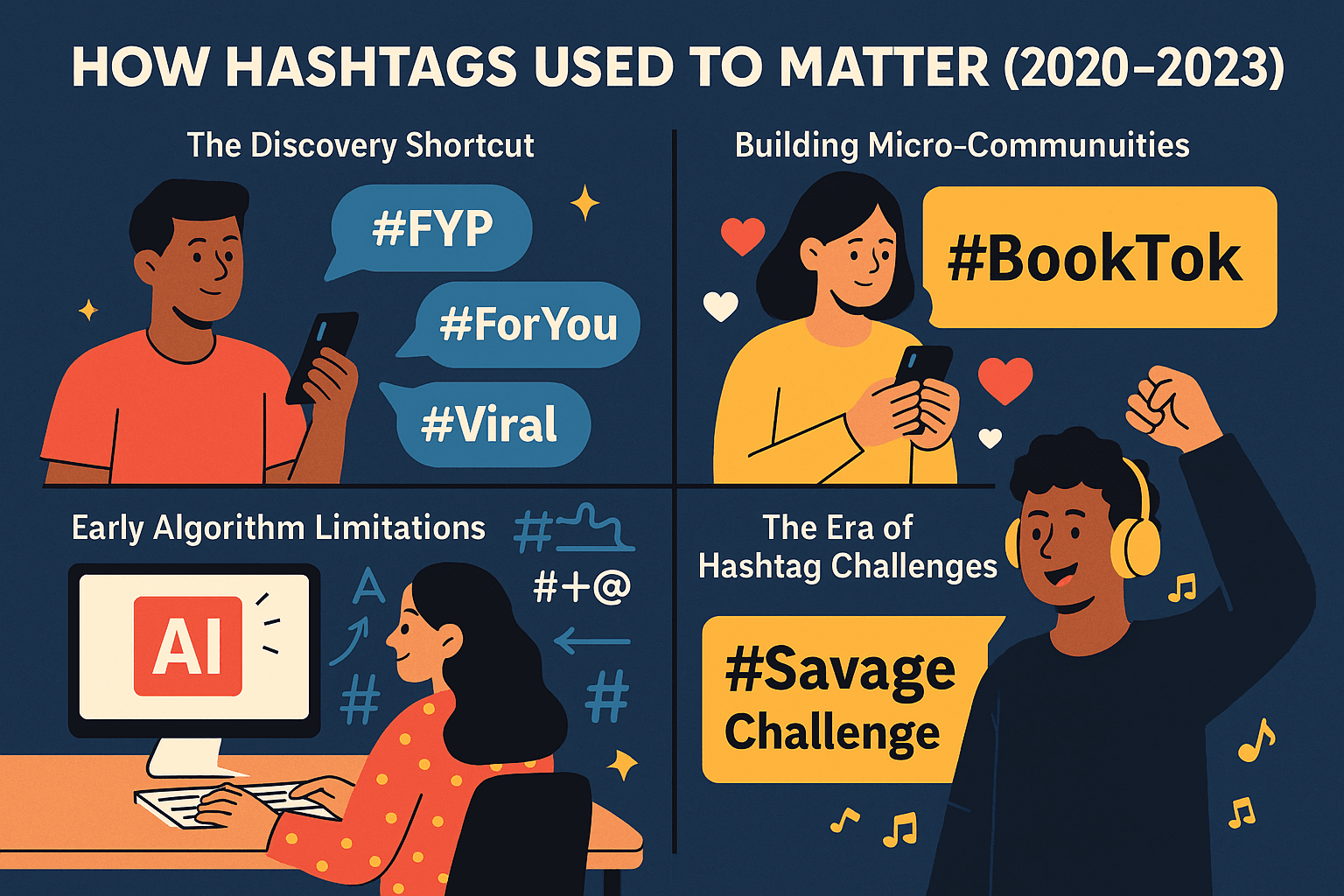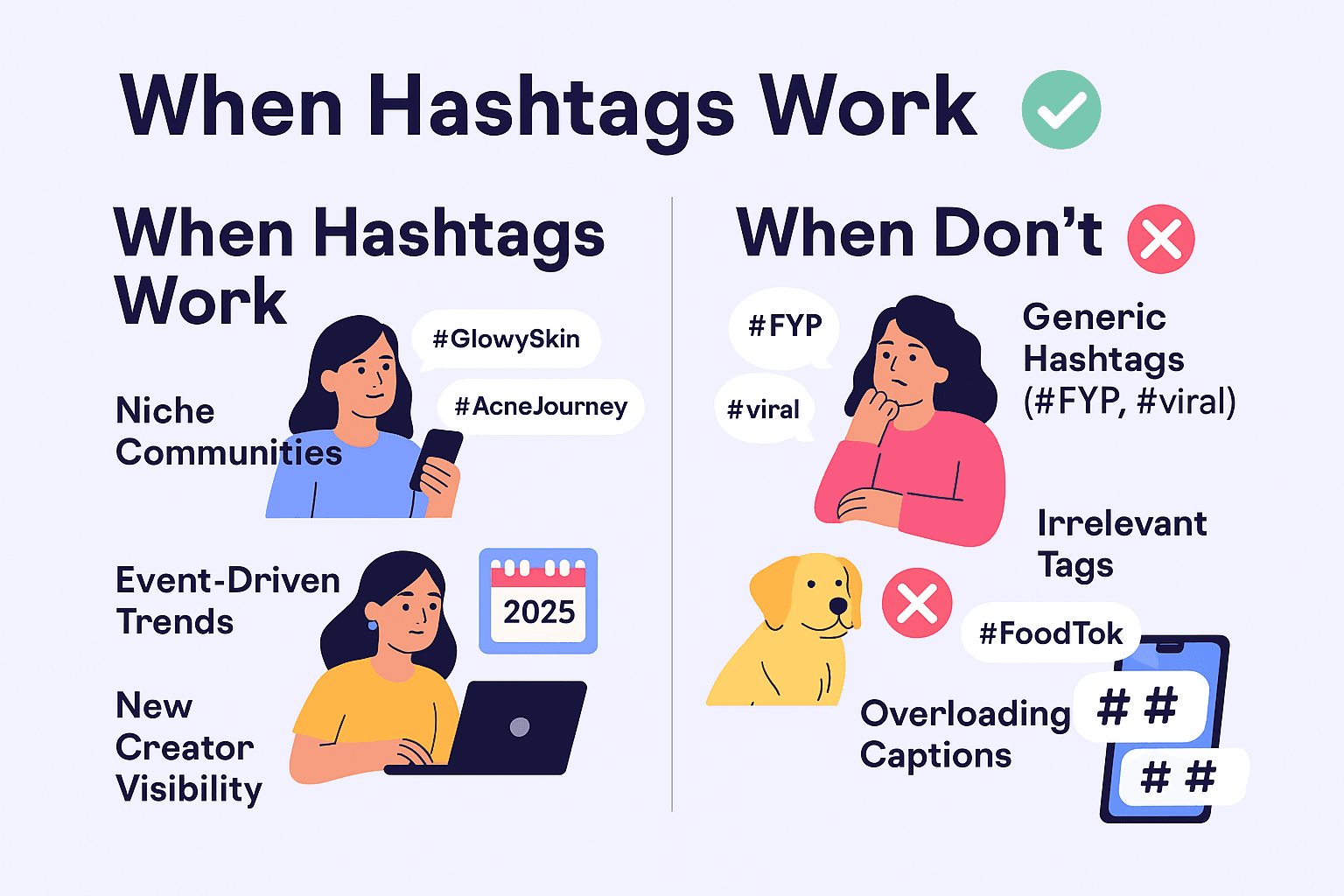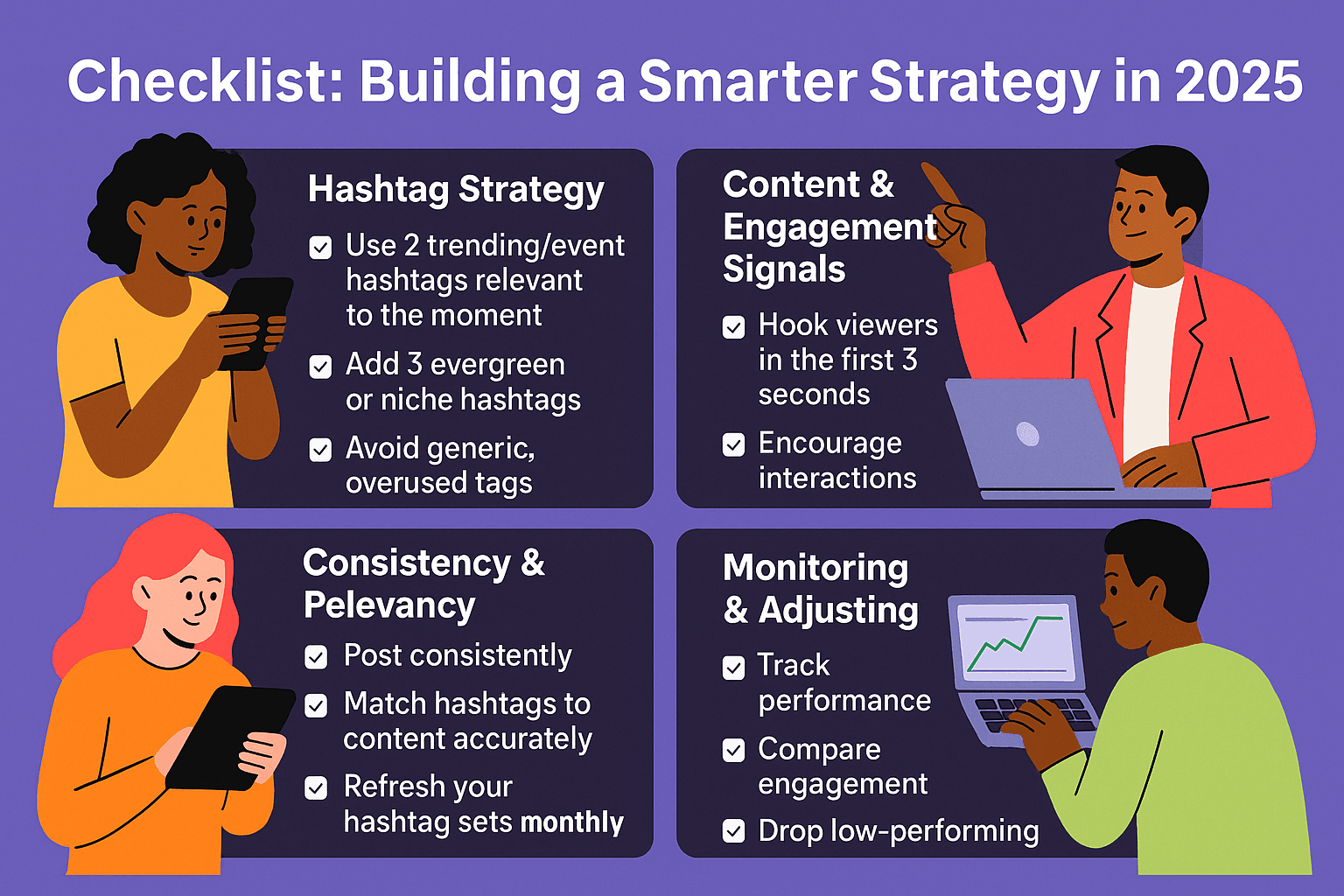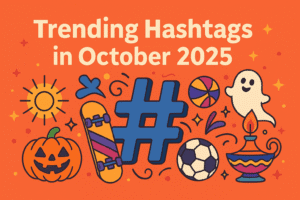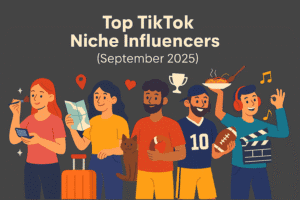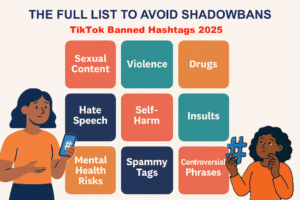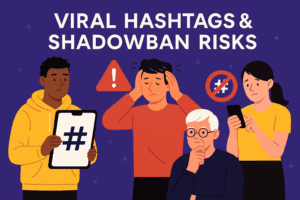How Hashtags Used to Matter (2020–2023)
In TikTok’s early years, hashtags were more than just labels — they were entry tickets into viral conversations. Between 2020 and 2023, the platform was still in rapid growth mode, and hashtags gave both users and the algorithm an easy way to organize content.
Looking back, hashtags acted as the training wheels for TikTok’s algorithm. They gave the system context when it didn’t have enough data. Today, the algorithm has matured, but knowing this history explains why hashtags still have symbolic — if not central — value.
1. The Discovery Shortcut
- Back then, hashtags like #FYP, #ForYou, and #Viral were believed to be golden keys.
- While not officially confirmed by TikTok, millions of creators swore that simply adding these boosted their odds of landing on the For You Page.
- In reality, what hashtags did was create massive content pools where the algorithm could sample videos.
2. Building Micro-Communities
- Hashtags didn’t just drive reach — they built subcultures.
- Movements like #BookTok, #FoodTok, and #PetTok formed because people rallied around hashtags as identity markers.
- For creators, using the right community hashtag often meant instant access to a loyal, pre-built audience.
3. Early Algorithm Limitations
- From 2020 to 2021, TikTok’s algorithm was still evolving. It relied heavily on textual signals (captions, sounds, hashtags) to categorize videos.
- That meant hashtags had disproportionate influence compared to today. If you nailed your hashtags, you could bypass weaker engagement.
4. The Era of Hashtag Challenges
- Brand activations and viral movements often started with hashtags — think #InMyFeelingsChallenge or #SavageChallenge.
- These weren’t just fun trends. For marketers, they were one of the first reliable ways to measure TikTok ROI.
The Algorithm Shifts of 2024–2025
By 2024, TikTok’s algorithm had advanced far beyond its early reliance on hashtags. Machine learning models became smarter at predicting user preferences based on behavioral signals rather than just metadata. This evolution reshaped how content is discovered — and it’s the main reason hashtags have lost their old dominance.
1. From Hashtags to Behaviors
- Instead of focusing on text-based signals like hashtags, TikTok shifted its weight toward watch time, replays, shares, and saves.
- A video with no hashtags but strong engagement could outperform a hashtag-loaded post.
- This change reflected a deeper truth: TikTok’s goal is to maximize retention, not keyword matching.
2. Rise of Semantic Understanding
- The algorithm now uses AI-powered video recognition to analyze visuals, sounds, and context.
- For example, a video showing a pumpkin spice latte in September may trend under “fall food” content — even without the hashtag #pumpkin.
- Hashtags became more like “supporting context” rather than primary signals.
3. Personalized Micro-Feeds
- In 2025, the FYP feels less like a single feed and more like a customized set of mini-communities.
- Users are automatically placed into interest clusters (e.g., fitness, comedy, gaming) based on engagement.
- This makes hashtags optional — since TikTok already knows your video’s “fit” based on audience behavior.
4. Decline of Generic Tags
- Once-powerful hashtags like #FYP or #viral no longer carry weight.
- TikTok deprioritized them after spammy overuse, favoring more authentic behavior-driven signals.
- Creators who still rely solely on these generic tags see diminishing returns in 2025.
Hashtags didn’t vanish — but the algorithm now treats them as secondary markers. What truly drives reach is how well your content engages real users in the first 3–5 seconds.
Case Study: When Hashtags Work vs When They Don’t
Hashtags aren’t dead in 2025 — but they’re situational. In some contexts, they still amplify discovery, while in others, they have little to no impact. Let’s look at two contrasting scenarios.
Hashtags are no longer a growth engine on their own. Instead, they’re a supporting tool — best used to target niches, ride events, or support new accounts. In other cases, the algorithm alone dictates success.
When Hashtags Work
Niche Communities:
Example: A skincare creator uses #GlowySkin or #AcneJourney.
Why it works: These tags attract audiences with very specific interests. Even if the algorithm already recognizes the content, hashtags help creators join community conversations.
Event-Driven Trends:
Example: #MetGala2025 or #SuperBowlAds.
Why it works: TikTok’s algorithm may surface trending topics automatically, but hashtags give creators direct access to the surge of real-time discovery.
New Creator Visibility:
For smaller accounts, hashtags still serve as a way to signal relevance and join searchable pools.
Without them, new videos risk being siloed into low-exposure test groups.
When Hashtags Don’t Work
Generic Hashtags (#FYP, #viral):
These once-powerful tags are now algorithmically ignored due to overuse and spam.
Example: A video tagged #FYP with no other context won’t gain extra reach.
Irrelevant Tags:
Example: Posting a dog video with #FoodTok.
Why it fails: The algorithm detects mismatch between video content and hashtags, which can actually hurt trust signals.
Overloading Captions:
Example: Adding 20+ hashtags in hopes of “gaming the system.”
Why it fails: TikTok treats this as spam-like behavior, reducing credibility rather than boosting it.
Hybrid Approach: Combining Hashtags with Algorithm Signals
By 2025, the smartest TikTok creators aren’t asking “hashtags or algorithm?” — they’re asking “how do I make them work together?” The truth is, hashtags and algorithm signals aren’t enemies. When used strategically, they complement one another to give content the best chance of discovery.
The best 2025 TikTok strategy isn’t “hashtags vs algorithm.” It’s hashtags + algorithm. Use hashtags to give context, and let algorithm signals prove value. Together, they create a balanced growth system.
1. Hashtags as “Context Labels”
- Hashtags are no longer the primary growth lever, but they still act as metadata labels.
- Adding a niche tag like #PetTok or #StudyTips tells the algorithm where to place your content.
- Think of hashtags as signposts — they don’t carry the car, but they guide it to the right road.
2. Engagement as the Real Fuel
- Once your video enters the algorithm’s testing phase, performance depends on behavioral signals:
- Watch time
- Replays
- Shares
- Saves
- Comments
- Even the best hashtags won’t save a video with poor engagement.
3. The “2 + 3 Formula”
- 2 trending/seasonal hashtags → capture immediate attention.
- 3 evergreen/niche hashtags → keep your video discoverable long-term.
- Example: For a fall beauty video → #fallnails #pumpkin + #BeautyTok #GlowySkin #MakeupTips.
4. Boosting Trust with Relevancy
- When your hashtags accurately reflect your content, the algorithm recognizes alignment.
- This strengthens your “account trust score,” making future videos more likely to be pushed onto the FYP.
- Mismatched or spammy tags do the opposite — dragging down your discoverability.
The best 2025 TikTok strategy isn’t “hashtags vs algorithm.” It’s hashtags + algorithm. Use hashtags to give context, and let algorithm signals prove value. Together, they create a balanced growth system.
Creator Insights: What Top Accounts Say About Hashtags
While TikTok’s algorithm is more powerful than ever, many top creators in 2025 agree on one thing: hashtags aren’t useless — but they’re not magic either. Their role has shifted from “growth engine” to “supporting tool.”
Hashtags still have a place in TikTok strategy — but only when used intentionally. The creators who win in 2025 are those who spend more time perfecting their content and let hashtags serve as a finishing touch, not a crutch.
1. Hashtags as Community Signals
- Popular creators in niches like #BookTok, #FoodTok, and #PetTok say hashtags still matter for staying connected to their community.
- Instead of chasing virality with #FYP, they focus on identity hashtags that anchor them within a loyal audience.
2. “Algorithm First” Mindset
- Big entertainment and lifestyle influencers often emphasize that success comes from watch time and engagement, not hashtags.
- As one fitness creator put it: “Hashtags might get me seen, but it’s the content that keeps me there.”
3. Strategic Minimalism
- Instead of stuffing captions with 10–20 tags, many top accounts limit themselves to 3–5 focused hashtags.
- The trend is toward quality, not quantity — hashtags as polish, not clutter.
4. Event-Driven Exceptions
- During seasonal or event spikes (#MetGala2025, #Olympics2024), even veteran creators rely on hashtags to plug into trending streams.
- Here, hashtags act less as SEO and more as real-time discovery hooks.
5. Creator Consensus in 2025
- Hashtags = context. Algorithm = power.
- Top creators treat hashtags as metadata that helps the algorithm place videos correctly — but they don’t rely on them as the sole driver of growth.
Building a Smarter Strategy in 2025
Think of hashtags as the map and the algorithm as the engine. Without the map, you risk missing your audience. Without the engine, you won’t move at all. Together, they drive sustainable TikTok growth in 2025.
If you want to win on TikTok in 2025, you can’t rely only on hashtags or only on the algorithm. The most effective strategy is a blend of contextual tagging and performance-driven content. Here’s your step-by-step checklist:
Hashtag Strategy
- Use 2 trending/event hashtags relevant to the moment (#fallnails, #MetGala2025).
- Add 3 evergreen or niche hashtags that anchor your content in a community (#BeautyTok, #PetTok).
- Avoid generic, overused tags like #FYP or #viral.
Content & Engagement Signals
- Hook viewers in the first 3 seconds to boost watch time.
- Encourage interactions (ask a question, invite comments).
- Aim for replay-worthy content — short loops, tutorials, or storytelling formats.
- Nudge for saves/shares by creating useful or entertaining evergreen content.
Consistency & Relevancy
- Post consistently (3–5 times per week minimum).
- Match hashtags to content accurately — relevancy builds your trust score.
- Refresh your hashtag sets monthly to reflect evolving trends.
Monitoring & Adjusting
- Track performance with TikTok Analytics → note which hashtags & signals correlate with spikes.
- Compare engagement on posts with hashtags vs without to refine your balance.
- Drop low-performing tags and test fresh niche ones.
Explore Related Guides
If you’re serious about building TikTok growth strategies in 2025, don’t stop here. Explore our related guides to strengthen your knowledge and stay ahead:
- TikTok Hashtags Strategy 2025: Do They Still Matter? — learn the evolution of hashtags and where they fit into growth today.
- Best TikTok Hashtags 2025: Boost Visibility Fast — curated collections of hashtags that actually work for creators this year.
- TikTok Banned Hashtags 2025: Full List to Avoid Shadowbans — avoid the tags that can quietly hurt your reach.
- Viral Hashtags & Shadowban Risks — understand when viral trends help you, and when they backfire.
TikTok Shadowban Guide 2025 — everything you need to know about shadowbans, from causes to recovery.
Use this cluster of resources together. Each guide builds on the other — giving you a full roadmap to master TikTok hashtags and algorithm strategies without falling into common traps.
Hashtags vs Algorithm — Who Wins in 2025?
In 2025, the debate isn’t really about hashtags vs algorithm anymore. The real answer is that they play different but complementary roles.
Hashtags act as contextual signals — guiding your video into the right conversations and communities.
The algorithm is the decision-maker — weighing engagement metrics like watch time, replays, shares, and saves to determine whether your video deserves mass exposure.
If you rely only on hashtags, you’ll miss the power of TikTok’s personalization engine. If you rely only on the algorithm, you risk not being placed in the right pools to begin with. The winning formula is a hybrid strategy: using hashtags to provide clarity and letting the algorithm amplify quality content.
The bottom line?
Hashtags still matter — but the algorithm decides who wins.
For creators, that means focusing less on “gaming the system” with generic tags and more on crafting content that sparks genuine engagement. When paired with the right hashtags, this is what ensures long-term growth on TikTok in 2025.
